Table of Contents
- What Is a Small Community Wind Project?
- Understand Your Energy Use & Costs
- Research Local Incentive Programs
- Understand Your Wind Resource
- Research Turbine Models
- Calculate Simple Payback
- Understand Preliminary Siting
- Understand Permitting & Zoning
- Engage with Neighbors
- Conduct a Wind Resource Estimate
- Research Interconnecting Behind Your Meter
- Research Project Economics & Financing
- Select the Final Design & System Specifications
- Submit Permit Applications
- Find an Installer
- Purchase Equipment
- Plan for Maintenance
- References
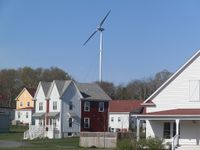
The Sandywoods community in Rhode Island features a community wind project. Photo from Stefan Dominioni, NREL 26490
Community wind projects are locally owned developments consisting of turbines that can vary in number, type, and size. Historically, these projects have been utilized to supply local electricity for a variety of applications, including schools, hospitals, businesses, farms, ranches, or community facilities. Rural electric cooperatives or municipal utilities have also developed their own community wind projects to diversify electricity supplies. Community wind owners may also be local individuals who form independent power producer groups or limited liability corporations to sell the power the turbines produce to a local electricity supplier.[1]
Locally owned community wind projects create even more of an economic opportunity for those involved than conventional wind farms owned by companies with limited local ties. Compared to conventional wind power projects, community wind projects have a greater impact in terms of economic benefits because of two key factors: the project being locally owned and overall project profitability. Research indicates that "construction-period employment impacts are 1.1 to 1.3 times higher and operations-period impacts are 1.1 to 2.8 times higher for community wind versus conventional wind power projects."[2] The level of increased economic benefits is determined by the availability and use of local, qualified labor and supplies, as well as the ownership structure and financing details.[1]
Why Community Wind Projects?
Because community wind projects are locally owned, residents can influence the siting and sizing of projects and ensure that local interests are honored.[1] The local community can develop guidelines for establishing local ordinances, ensuring that future projects will follow regulations established for setbacks, sound levels, and aesthetics of future wind projects.
With the combination of no fuel costs and relatively low operating costs, owners of community wind projects can confidently predict the price that they will pay for energy throughout the lifetime of the project.[1] Community wind projects produce energy that can be used directly or sold to local utilities at a fixed rate through a power purchase agreement, providing long-term energy price stabilization. In areas where importing fuel results in high electricity costs, developing community wind projects can stabilize or lower energy costs.
Plans for siting new energy projects in a community—whether oil and gas wells, nuclear power plants, solar farms, or wind farms—are often met with opposition. Community wind projects garner high levels of support from people living in nearby communities. Increased local acceptance and public support may result from the involvement of local residents as investors or shareholders in these developments.[3][4][5][6] The variety of different applications for which community wind projects can be used may also be a factor in garnering support for the project from local residents.
Community wind projects generally operate on a smaller scale than utility-scale wind farms, so they may not require transmission upgrades. Most community wind projects can be easily connected to the distribution grid.[1]
Electricity production from wind turbines does not pollute the water we drink or the air we breathe. Also, wind energy requires no mining, drilling, or transportation of fuel and it poses no risk of large-scale environmental contamination.[1]
A majority of community wind projects are located in rural areas where water conservation is a serious concern. Community wind energy can become part of the solution when examining energy production and potential water savings. Wind energy requires minimal amounts of water, whereas thermal generators are among the largest consumers of water in the United States.[1] By diversifying the local energy supply, communities can help manage the water supply risks on a local level.
This handbook was designed to provide guidance for the siting and development activities required to develop a small wind project ($10,000 – $100,000) in your community. For large wind projects ($2 million+), see the Large Community Wind Handbook. Following the steps outlined in this handbook will help with the development of a successful project.
What Is a Small Community Wind Project?
A small community wind project is defined in this handbook as a community wind project that costs between $10,000 and $100,000.
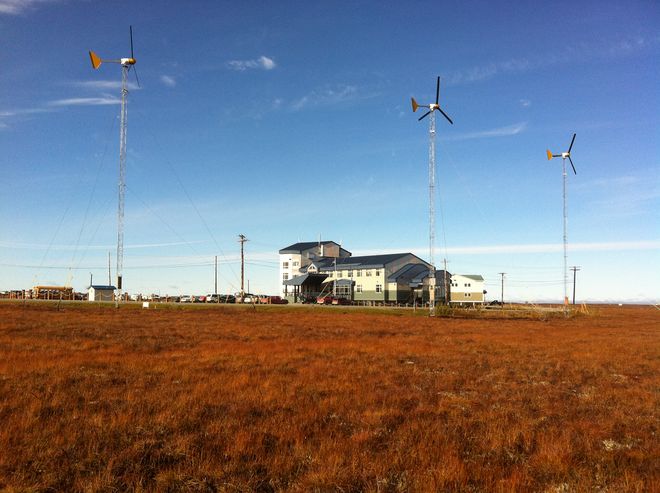
Three Excel 10S turbines on 80-foot GL towers provide power to a school in Bethel, Alaska. Photo from Pieter Huebner, NREL 26471
The capacity-weighted average cost of small wind projects installed in 2021 was $5,120/kilowatt (kW) (based on 16 projects in three states for a combined rated capacity of 396 kW).[7] Considering the cost range for a small community wind project and the capacity-weighted average to install a small wind turbine, a typical small community wind project would consist of a turbine or turbines with a total capacity factor of up to approximately 14 kW. This project size usually allows homeowners, businesses, schools, municipalities, and other organizations to independently produce enough energy to meet part of their needs or to reduce their energy costs.
Understand Your Energy Use and Costs
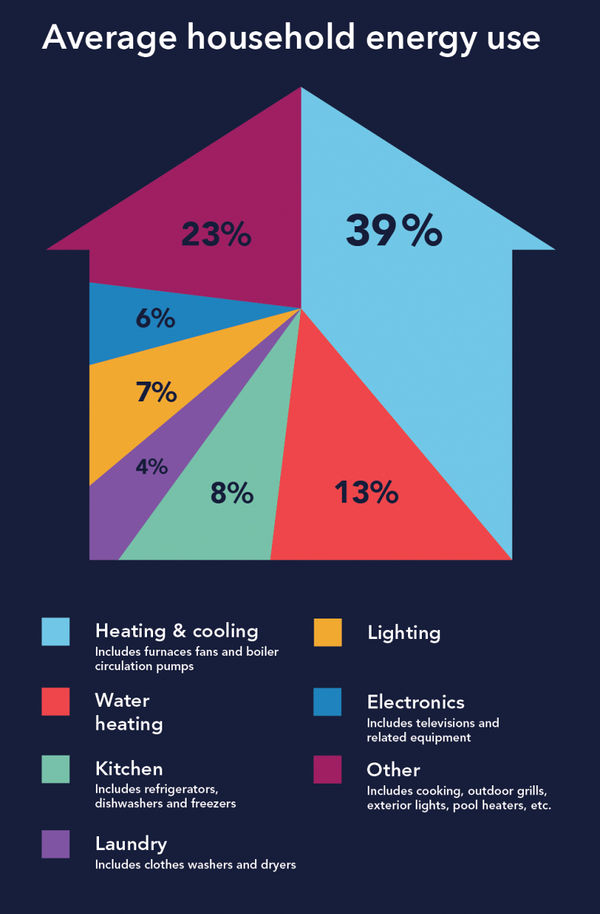
Credit: U.S. Department of Energy - Energy Saver: How Appliance Standards Help Consumers Save Big infographic
Understanding your energy usage and the associated costs is essential in determining the turbine size needed for your small community wind project. For example, in 2020 a typical U.S. home used approximately 10,715 kilowatt-hours (kWh) of electricity per year (about 893 kWh per month).[8]
Depending on the average wind speed in an area, a wind turbine rated in the range of 5 to 15 kilowatts (kW) would be required to make a significant contribution to this demand. A 1.5-kW wind turbine will meet the needs of a facility requiring 300 kWh per month in a location with a 14 MPH (6.26 meters per second) annual average wind speed.[9]
Research Local Incentive Programs
Costs associated with small community wind projects can be offset if owners can take advantage of incentives for small wind installations. One important incentive for small wind installations is net metering.
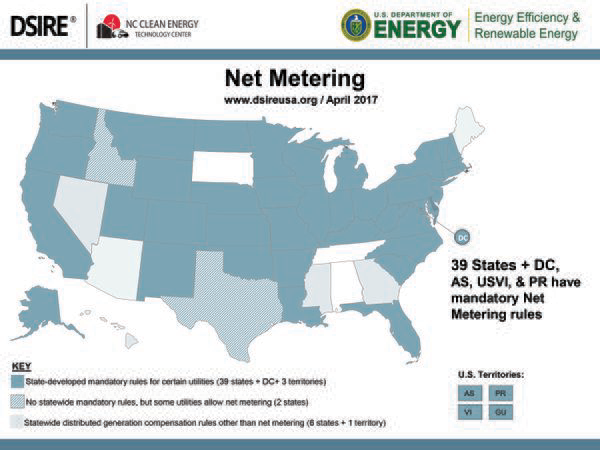
The Database of State Incentives for Renewables and Efficiency's Net Metering Policies summary map is updated quarterly to reflect current net metering policies in the United States.
Net metering allows the electric meters of small wind turbine project owners to turn backward when the project produces more energy than the customer uses. Net metering programs vary by state and by utility company. Net metering also enables customers to use the energy they produce to offset consumption over an entire billing period, not just instantaneously. This offset enables customers with generating facilities to receive retail prices for more of the electricity they generate.
Net metering programs specify a method to handle the net excess generation in terms of compensation for electricity and/or defining the period of time allowed for net excess generation credit. Net metering requirements that define net excess generation on a monthly basis only allow consumers to receive credit for their excess that month. When net metering rules allow for annual net excess generation, the credit can be carried for up to a year. Since most of North America sees more wind in the winter than in the summer, people using wind energy to displace a large load in the summer (like air conditioning or irrigation water pumping) may find it beneficial to have an annual credit that allows them to produce net excess generation in the winter and receive credits in the summer.[10]
If you are interested in installing a small community wind project, it is important to ensure that your state's net metering rules cover your utility. Some states' regulations concern only investor-owned utilities and do not include rural electric cooperatives or municipal electric utilities.[11]
To research your state's net metering rules, check the Database of State Incentives for Renewables and Efficiency (DSIRE).
Understand Your Wind Resource, Conduct a Preliminary Estimate
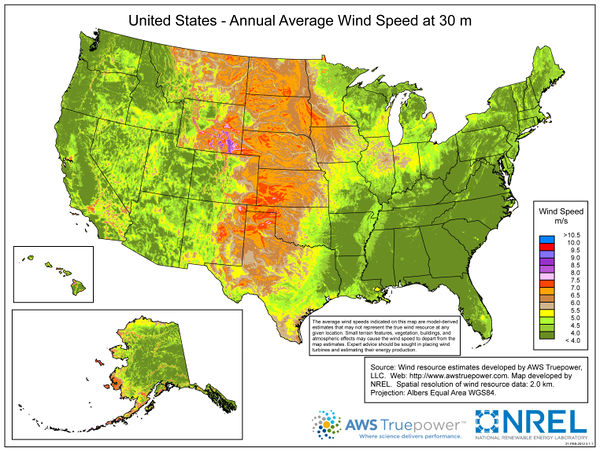
The U.S. Department of Energy provides 30-meter (m) height, high-resolution wind resource maps for the United States. Businesses, farms, and homeowners use residential-scale wind resource maps to identify wind sites that may be appropriate for small-scale wind projects.
Prior to selecting the size of the wind system for the project, it is important to understand the wind resource at the location. A preliminary estimate helps determine which model type will best suit the site prior to spending the time and energy researching the system pricing.
Some small wind project developers use state wind maps to conservatively estimate the wind resource at turbine hub height. While these maps can provide a general indication of good or poor wind resources, they do not provide a resolution high enough to identify local site features.
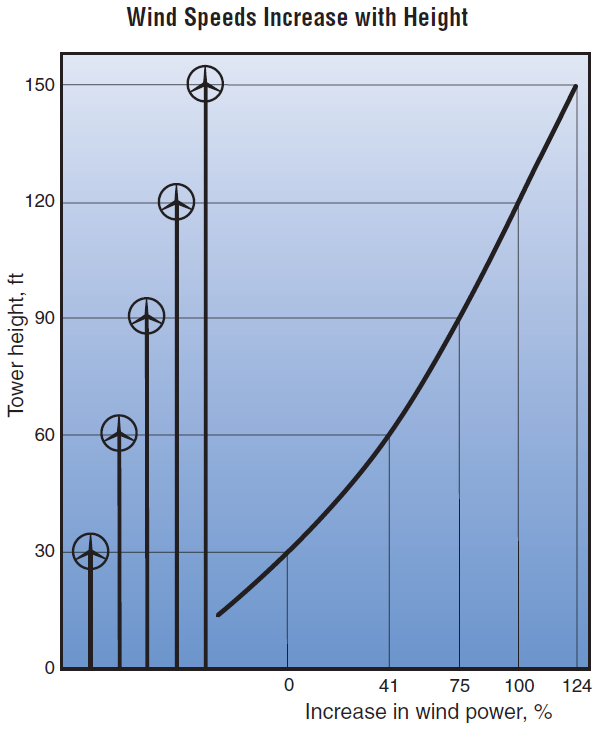
State wind maps cannot include information on complex terrain, ground cover, wind speed distribution, direction distribution, turbulence intensity, and other local effects. Purchased maps or services can often provide higher resolution and more flexibility with zooming, orientation, and additional features. Pay attention to a map's height above ground as it relates to the potential project's tower height. Adjusting the wind speed for the height difference between the map and the turbine height adds a potential source of error depending on the wind shear exponent that is selected, and the greater the height difference the greater the potential error. Therefore, for small wind generator applications, 30- to 40-m wind maps are far more useful than 10-, 60-, 80-, or 100-m wind maps. It is also important to understand the resolution of the wind map or model-generated data set. If the resolution is lower than the terrain features, adjustments will be needed to account for local terrain effects.[12]
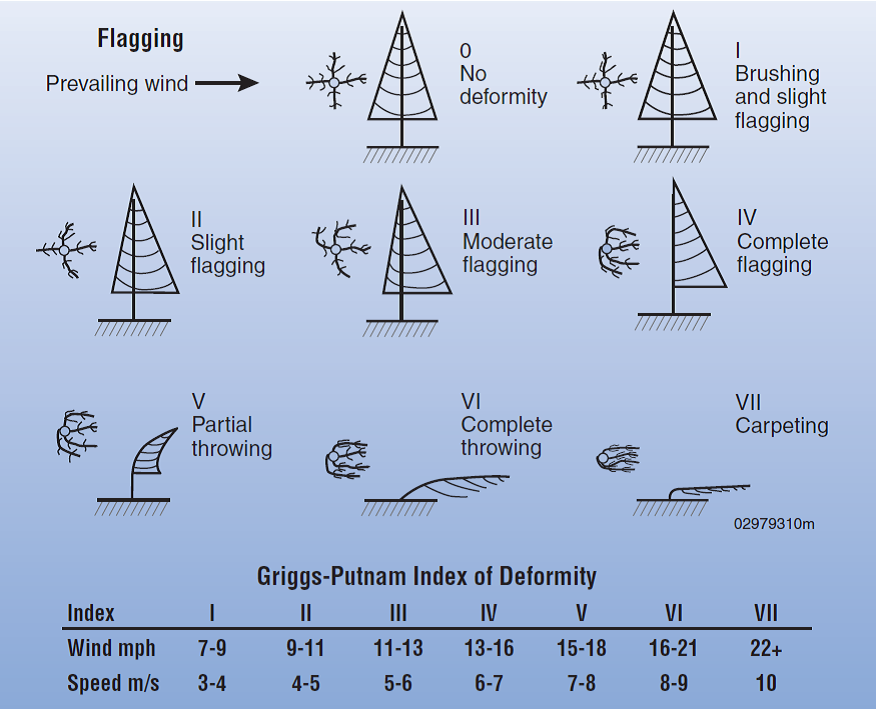
Flagging, the effect of strong winds on area vegetation, can help determine area wind speeds.
Local airport or weather stations can offer local wind data, but these data may be less reliable than actual site data. If airport data (typically recorded at 30 ft or 10 m above ground) or weather station data (typically recorded at 5 to 20 ft above ground) are used, inquire not only about the site's current equipment and location but also if it is historically consistent with the data collection equipment and siting. Equipment at these sites is not primarily intended for wind resource assessment, so it may not be positioned at an appropriate height or in a location free of obstructions. Unfortunately, airport and weather stations are usually far from the site of interest, with considerably different orography, tree cover, and monitoring height, making these data of questionable usefulness. Given the expertise required to effectively establish and correlate wind resource data, the data provided by airport and weather stations may only provide a rough screening assessment.[12]
Average wind speeds increase with height and may be 15% to 25% greater at a typical wind turbine hub height of 80 ft (24 m) than those measured at airport anemometer heights. The National Climatic Data Center collects data from airports in the United States and makes wind data summaries available for purchase.
An additional useful indirect measurement of the wind resource is the observation of an area's vegetation. Trees, especially conifers or evergreens, can be permanently deformed by strong winds. This deformity, known as "flagging," has been used to estimate the average wind speed for an area.[13]
Research Turbine Models
Now that you know how much energy you use and you understand your wind resource, it is time to begin researching turbine sizes and models. Deciding on a capacity while fulfilling the characteristics you are looking for will narrow the number of turbines to research. Characteristics include whether the turbine is certified, horizontal- versus vertical-axis machines, warranties, as well as how much energy you plan to produce.
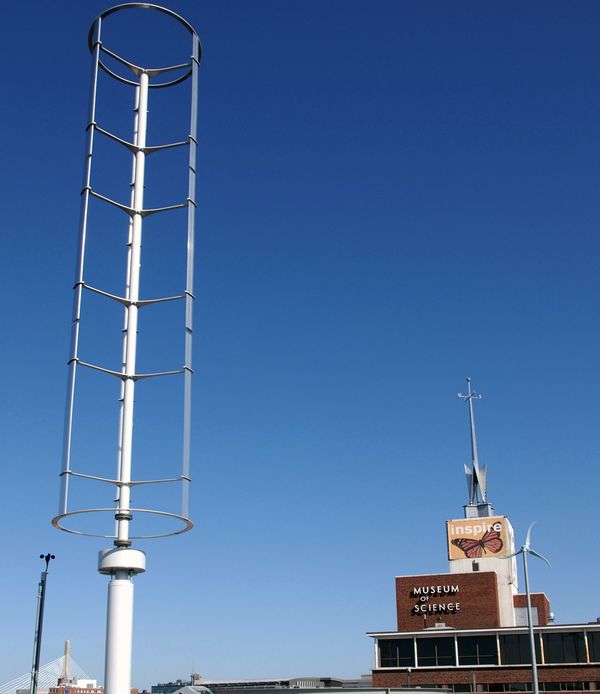
A vertical access wind turbine installed at the Boston Museum of Science. Photo from Boston Museum of Science
One resource to help consumers select small wind turbines that are safe and reliable investments when properly installed is the Small Wind Certification Council (SWCC), which provides independent, accredited certification of small wind turbines and consumer information. The organization, formed by industry members, has certified several small and medium wind turbine models and plans to certify more.[14]
The National Renewable Energy Laboratory's (NREL's) National Wind Technology Center supports the continued market expansion of distributed wind by engaging in partnerships with manufacturers to evaluate existing hardware in targeted testing campaigns and improve new designs. In 2009, the U.S. Department of Energy and NREL selected four partners (Intertek Testing Services NA, Inc. in New York; Kansas State University; Windward Engineering, LLC in Utah; and the West Texas A&M — Alternative Energy Institute) to establish small wind Regional Test Centers to conduct tests on small wind turbines to meet national and international standards. Though the project ended in early 2016, reports from these Regional Test Centers are available to consumers through the partner links above.
The implementation of the North American Board of Certified Energy Practitioners (NABCEP) Small Wind Installer Certification was an additional step to ensure installers were qualified, but as of July 2012, the NABCEP certification was suspended. Sixteen installers throughout the United States hold the credential. At the NABCEP website, you can find more information or a certified installer.
While certified installers are an option for those interested in a turbine, some people choose to install a project themselves to reduce project costs. Interest in small wind site assessment courses, training, and certifications is increasing. The Midwest Renewable Energy Association offers a Renewable Energy Site Assessment Certificate Program, and NREL has published a Small Wind Site Assessment Guidelines report. Programs and materials like this can result in qualified assessors who can work on project installations, ensuring that turbines operate at their full potential.
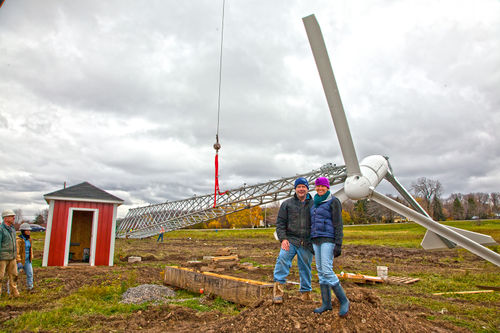
A Bergey 10-kW turbine being installed on a 120' SSL tower for a winery in Lockport, New York. Credit: Niagara Wind & Solar, Inc.
When comparing turbines, it is important to obtain and review the product literature from several manufacturers and to research the companies to ensure they are recognized wind energy businesses and that parts and service will be available when you need them. Research could include contacting the Better Business Bureau and asking manufacturers for references from past customers with installations similar to the one you are considering. Learning about a system owner's experiences concerning performance, reliability, maintenance and repair requirements, and whether the system meets expectations is integral in thoroughly researching a wind turbine for a small community wind project.[15]
Also integral to the research process is understanding warranties and the availability of local operations and maintenance (O&M) providers for each of the wind turbine models that you are considering. Warranties can range from a standard 2-year parts-and-labor package, which can include a power curve and availability warranty, to an extended warranty of up to 5 years at an additional cost. Warranties typically deal with design and manufacturing errors and supply replacement parts and labor.
An additional factor to consider is the proximity of O&M providers. Travel could increase the overall maintenance costs for the project, and unscheduled maintenance could become more of an issue if O&M providers are located far away from the project. It is important to note that although you may utilize third-party O&M companies to service turbines, it may void the original warranty if they are not approved by the manufacturer.[16]
Calculate Simple Payback
The Small Wind Economic Model is a Microsoft Excel spreadsheet that can help you analyze the economics of a small wind electric system and decide whether wind energy will work for you. You provide information about how you will finance the system, the characteristics of your site, and the properties of the system you're considering. The tool then provides you with a simple payback estimation (it assumes no increase in electricity rates) in years. If the number of years required to regain your capital investment is greater than or almost equal to the life of the system, then wind energy will not be practical for you. A more in-depth explanation of payback with links to additional resources is provided later in this guidebook.
Understand Preliminary Siting
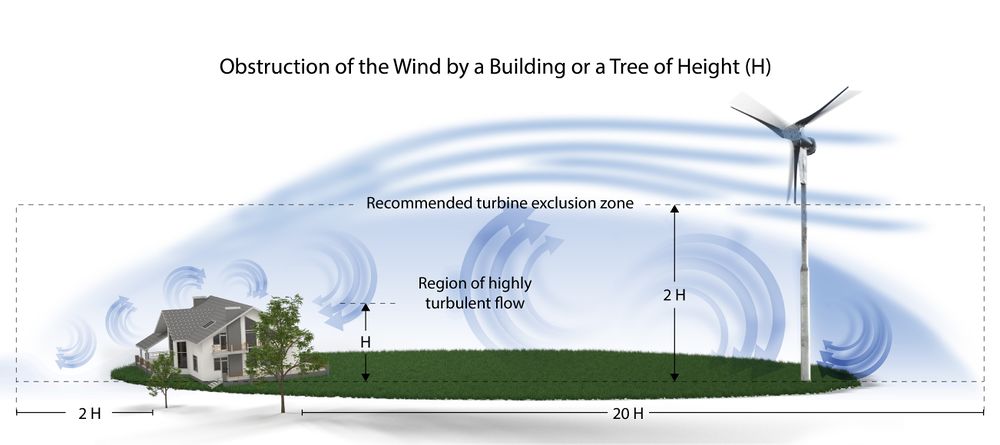
The farther you place your wind turbine from obstacles such as buildings or trees, the less turbulence you will encounter.
Wind turbines operate best in open areas with limited to no obstruction in the prevailing wind resource direction. If you live in complex terrain, it is important to take care in selecting the installation site. If you site your wind turbine on the top of or on the windy side of a hill, for example, you will have more access to prevailing winds than in a gully or on the leeward (sheltered) side of a hill on the same property. In addition to geologic formations, you need to consider existing obstacles such as trees, houses, and sheds, and you need to plan for future obstructions such as new buildings or trees that have not reached their full height.[9]
Your turbine should be sited upwind of buildings and trees,[1] and it needs to be 30 feet above anything within a 500-foot horizontal radius.[12] You also need enough room to raise and lower the tower for maintenance, and if your tower is guyed, you must allow room for the guy wires.
Whether the system is stand-alone or grid-connected, you also need to consider the length of the wire run between the turbine and the load (house, batteries, water pumps, etc.). A substantial amount of electricity can be lost as a result of the wire resistance; the longer the wire run, the more electricity is lost. Using more or larger wire will also increase your installation cost. Your wire run losses are greater when you have direct current (DC) instead of alternating current (AC). So if you have a long wire run, it is advisable to invert DC to AC.[9]
Additional tips for preliminary siting of a small wind project include:
- Generate a local area map to help you better understand the topography, surface roughness (i.e., trees), and buildings relative to the primary wind direction.
- Generate a mailing list with contact information for neighbors living within a 1-mile radius. You will learn more about this in the Engage with Neighbors section of this handbook.
- Identify all airports and flight paths, both public and private, to identify any potential conflicts and issues with installing a small wind turbine.
- Once this is complete, combine all of the above elements on one map for easy viewing and an overall understanding of preliminary siting.
Understand Permitting and Zoning
To better understand local county and township rules regarding wind energy, you should first recognize the differences in regulation types, including ordinances, zoning, and permitting.
Ordinances are laws, often found within municipal codes that provide various degrees of control to local governments. These laws cover issues such as zoning, traffic, consumer protection, and building codes. A wind energy ordinance reflects local needs and wants regarding wind turbines within county or city lines and aids the development of safe facilities that will be embraced by the community.[17]
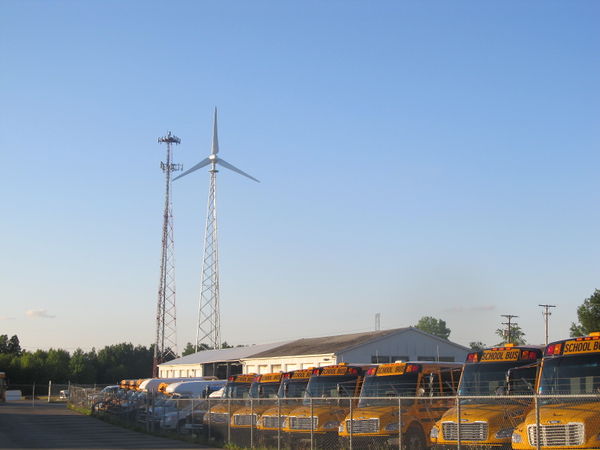
Myers Equipment Corp. - a full-service distributor of school buses, ambulances, and other truck equipment - is powered in part by a 50-kilowatt wind turbine. Photo from United Wind, NREL 26772
Unless the established ordinances are particularly restrictive, it may be easier to install a project in a jurisdiction that has an ordinance as opposed to a location without rules or general knowledge about wind energy.
Zoning is "a system of land use regulation that controls the physical development of land. It is a legal mechanism by which local government is able to regulate an owner's right to use privately owned land for the sake of protecting the public health, safety, and/or general welfare."[18] In terms of wind energy, that means that zoning basically controls whether an individual can install a wind turbine.
Permitting, on the other hand, controls how a wind turbine is installed, and it is an essential step in the turbine installation process. It is utilized so local governments can review and allow for wind energy developments. Permits are usually granted in accordance to the provisions of the ordinance regulating the development of wind systems.[19] By contacting your local authorities, you can learn the type of permitting needed for your project. Most jurisdictions with established ordinances pertaining to turbines allow the machines to be installed through permitted use, accessory use, or through a conditional use permit.
A conditional use permit allows the installation of a small wind turbine where it is not specifically prohibited but only if the project adheres to certain conditions and only in certain locations.[20]
In planning and zoning, accessory uses are typically defined as activities and land uses that are incidental, or secondary, to the primary use of the area.[21]
It should be noted that the cost of permitting varies by location and can add a substantial additional cost to a project. When you contact your local zoning administrators, be sure to ask about the costs and types of permits that will be needed for the project and also ask if any previously granted permits are available for review. These can provide insight and guidance for your project plan. A building permit or electrical permit may also be required for the project, which could add additional costs and time. Once you have spoken with your zoning administrator, you may want to create a requirements checklist to keep track of project details.
The time required to acquire permits for a small wind project can also vary by location. If there are other small wind turbine owners in your area, it would be beneficial to contact them to determine what to expect from the permitting process. It is essential to begin the permitting process early to ensure that the project can be completed prior to investing much time or money.
The two most important issues that can be raised during the permitting and zoning process for a small community wind project are setbacks and sound requirements. Setbacks are standards defined to create space between areas of concern and the wind project. Common areas of concern include property lines, inhabited structures, public roads, as well as communication and electrical lines. Sound requirements create a standard maximum level of allowed sound due to the operation of wind systems. These standards often include a defined method of measuring sound level.[19]
A project could be required to follow local environmental requirements and state siting guidelines. Contact your state energy office to inquire if this is the case in your area.
If you are installing a small community wind project in a location without a wind ordinance, it's possible that the local government will want to establish one prior to approving your installation. Model wind energy ordinances that have been written by various states and other organizations are available, and they can serve as guidelines for communities planning to establish a wind ordinance.[1]
Engage with Neighbors
In some cases, the success of your small community wind turbine can hinge on the support of your neighbors. Take the time to meet your neighbors early in the project planning process and begin establishing a positive relationship.
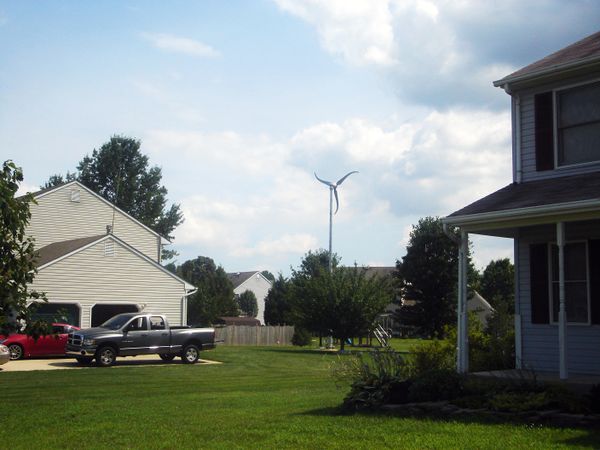
A Skystream wind turbine installation. Photo from Southwest Windpower, NREL 14935
When introducing the subject of the installation, be prepared to answer questions that might concern your neighbors. These questions may involve the visual impact of the tower and turbine; the potential sound of the system; and the system's proximity to buildings, neighboring property lines, and any environmentally sensitive areas. Remember, neighbors are usually much more accepting of an installation if you are upfront about your intentions and describe the project to them during the planning stages.[22]
Conduct a Wind Resource Estimate
Multiple tools are available to help you assess the resource of a particular site to ensure that the wind project lives up to its full potential. As a first step, you can consult a wind resource map, which is used to estimate the wind resource in your area. The U.S. Department of Energy provides high-resolution wind resource maps by state at a 30-meter (m) height. The actual wind resource on your site will vary depending on topography and structure interference, but these maps provide a good place to start. Localized sites with good winds, such as a ridge top, may not appear on the maps.[23]
Small wind site assessors can help you determine whether you have a good wind resource on your site. State or utility incentive programs may be able to refer you to site assessors trained to assess the wind resource at specific sites. Computer programs that estimate the wind resource at a particular site with specific obstacles are also available. Site assessors and computer programs can help to refine the estimates provided on wind resource maps.
Although there may be many methodologies for understanding the wind resource at a specific location, gathering on-site, measured wind data is typically preferred.
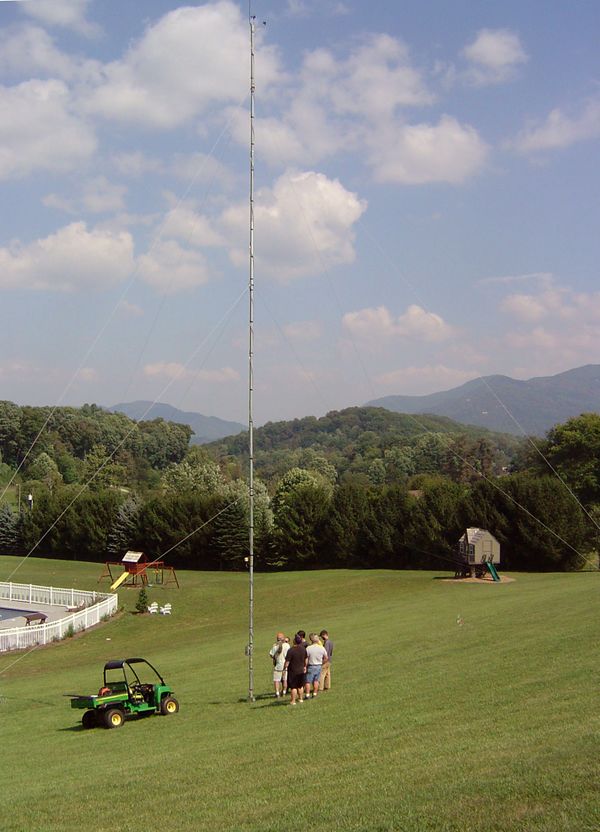
A team from Appalachian State University installs a wind measurement tower. Photo from Appalachian State University, NREL 15302
Direct monitoring by a wind resource measurement system at a site provides the most accurate picture of the available resource, but at a cost. Wind measurement systems are available; whether this expense is justified depends on the nature of the proposed small wind turbine system and its costs. Systems can be purchased for as low as $600 to $1,200.[24] Whether you should conduct direct monitoring for a small community wind installation depends on the uncertainty and risk regarding the project. Experts have suggested that the cost becomes more justifiable for systems 50 kilowatts and above.[25]
Computer modeling can be used to extrapolate wind conditions at a specific site based on historical data. Often computer models of a site's resource can be less expensive than conducting direct monitoring for a year or more.[26]
The measurement equipment must be placed high enough to avoid turbulence created by trees, buildings, and other obstructions. The most useful readings are those taken at hub height.[24]
Long-term reference points, like an airport or weather station, can also be beneficial in assessing the wind resource in your area. The data from these reference points can help determine the inter-annual variability of the wind in the area.[27]
If there is a small wind turbine in your area, you can contact the owner of the system to ask whether you can access any information on the annual output of the system and any available wind speed data.[24]
Research Interconnecting Behind Your Meter
The first step to understanding interconnection is to contact your local utility. Most utilities and other electricity providers require that you enter into a formal agreement before you are allowed to interconnect your wind turbine with the utility grid, so it is important to involve them early in the process.
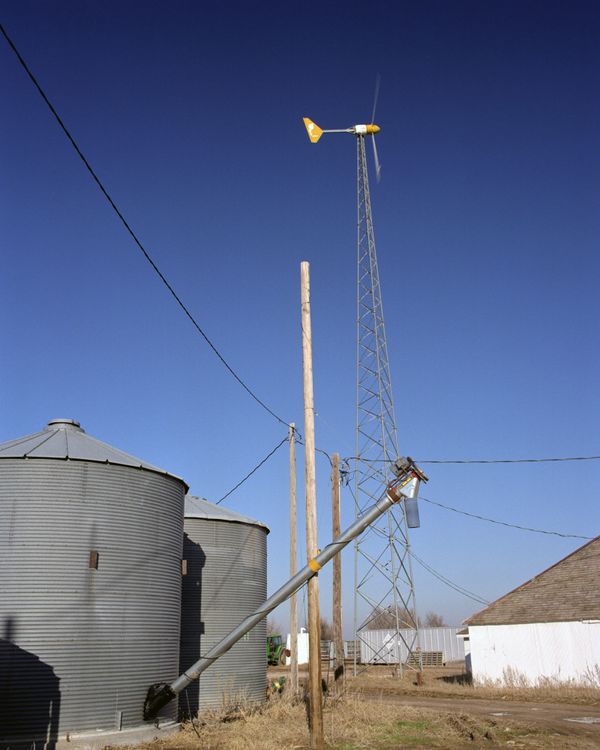
Small wind turbines, like this grid-connected Bergey 10-kW Excel, can provide supplemental power for farms and ranches. Excess power is fed back into the utility grid. Photo by Warren Gretz, NREL 09633
Interconnection requirements vary from state to state. Most state interconnection procedures have created several levels of review and documentation based on system size, with simplified processes for smaller inverter-based systems.
Be sure to discuss interconnection costs with your utility. These can include related application and connection fees and engineering, and technical charges. It is also important to ask what equipment is necessary for the interconnection, what costs are associated with it, and who is responsible for paying those costs.[1]
Now you can provide the utility with an estimated timeline for your project and begin forming a schedule for the future interconnection of your turbine.
Research Project Economics and Financing
Generally defined as the amount of time it takes for a wind turbine to pay for itself through the energy it produces, the payback period for a project could be a determining factor regarding whether your small community wind project moves forward. Payback periods can range from several years to several decades, depending on system cost, the price of electricity, the incentives provided for the project, and the average annual wind speed at the hub height of the wind turbine. Small increases in wind speed can result in increases in potential output. Relatively small investments spent increasing the height of your project can yield very high rates of return in power production because you expose the turbine to higher wind speeds.

The U.S. Department of Energy offers a Small Wind Economic Model, a spreadsheet tool that can help you analyze the economics of your small community wind project to help decide whether wind energy will work for you. To calculate payback, you must understand certain project details. According to Windustry, these include:
- A reasonable wind resource estimate
- Tower height
- The system's power curve (can be obtained from the manufacturer)
- The installed cost of the turbine
- Annual costs (maintenance, insurance, utility fees, etc.)
- Cost of energy
- Historical electricity consumption on a monthly basis, if available
- Information from your utility about system size limits, net metering structure, and compensation rate for energy sold back to the utility
- Loan interest rate for equipment purchased
- Information about available grants and incentives.[28]
A small wind turbine adds value to a property, thus a property tax increase is possible. Many states offer property tax exemptions or other forms of property tax incentives for small wind systems. You can search the Database of State Incentives for Renewables and Efficiency (DSIRE) for more information regarding which states have established property tax exemption policies.
DSIRE also offers a database of available federal and state grant programs and other incentives for wind projects, including small community wind installations. A funding source that has historically supported wind energy installations is the Rural Energy for America Program (REAP). REAP offers various grants and low interest loans for projects.
Also research whether your local utility currently offers any incentives for renewable energy projects. You can also consider speaking with an independent financial institution regarding a loan for your project.
Select the Final Design and System Specifications
One of the final steps in the installation of a small community wind system is selecting the turbine. When finally selecting your turbine size and model, it is important to conduct a performance assessment for each system you are interested in. It is essential to understand that a wind turbine's power rating is an incorrect metric to use when comparing different models. You should compare turbine models by looking at the number of kilowatt-hours of electricity the system will produce at your site per year. Comparing that number to the number of kilowatt-hours you use and the net metering policy of your utility will help in assessing which turbine will best suit your needs. To determine the annual energy output, you need to know the:
- Power curve for each turbine
- Average annual wind speed at your site
- Height of the tower that you plan to use
- Frequency distribution of the wind (an estimate of the number of hours that the wind will blow at each speed during an average year).
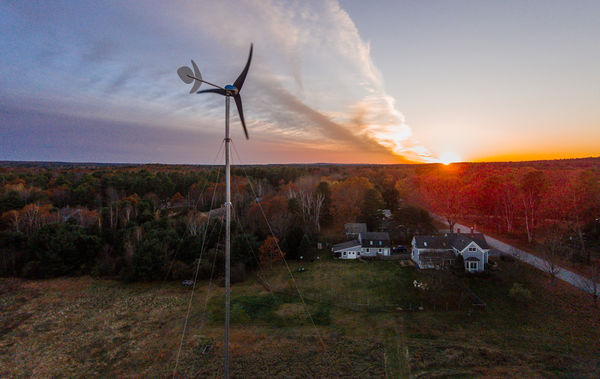
Pika Energy Turbine featuring blades manufactured through an injection mold process. Photo from Pika Energy, NREL 33943
It is also recommended that you adjust the calculation for the elevation of your specific site. To conduct a preliminary estimate of the performance of a particular wind turbine, you can use the following formula:
AEO= 0.01328 D2 V3
Where:
- AEO = Annual energy output (kilowatt-hours/year)
- D = Rotor diameter, feet
- V = Annual average wind speed, miles-per hour (mph), at your site.[9]
In terms of the actual system design, there are typically three types of small turbine configurations for a small wind turbine: self-commutated inverters, line-commutated inverters, and induction generators.
Self-commutated inverters, due to their own oscillators, need a reference from the utility grid to hold synchronization. When linked with a battery they may become part of an uninterrupted power supply, which is important in the event of a blackout.
Line-commutated inverters are actuated by utility line power and will cease to function during a blackout.
Induction generators produce grid-quality, constant-speed, AC power without the need for an inverter. An induction generator's output is regulated by the utility power; therefore if the grid blacks out, the generator will not produce output.[30]
After researching your options for turbine size, model, and configuration type based on performance and project economic assessments, it is time to weigh the other characteristics that are important to you (certified or not, vertical-axis or horizontal-access) and finalize your turbine selection and project specific details (location, height, and site plan).
Submit Permit Applications
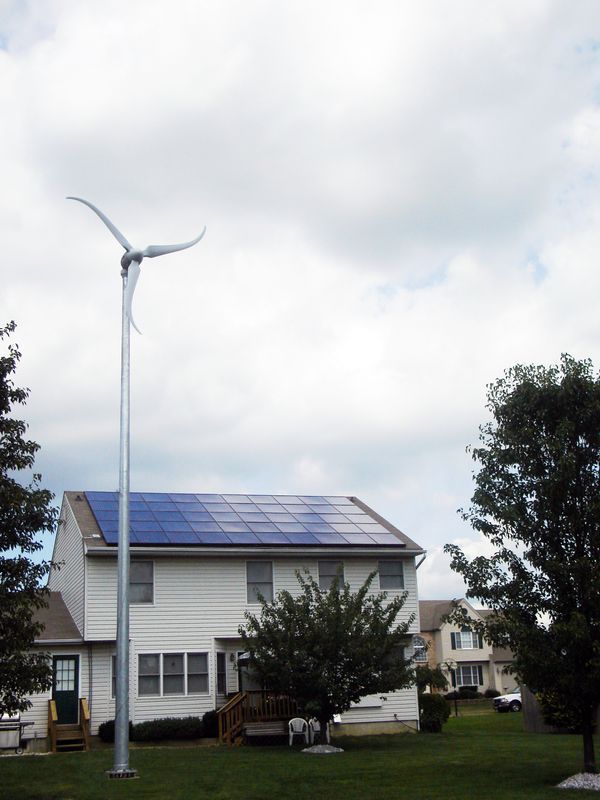
A Skystream turbine in a residential application. Photo from Southwest Windpower
Now that you've selected your system and finalized your project details, it is time to submit the applications for the various required permits. By now you should have compiled a knowledge base of permitting requirements and costs, project details, and various support documents (see Understand Permitting and Zoning). This information is critical during the permitting process and will need to be submitted to the proper authorities.
The time frame for permitting can vary, ranging from a few months to a year, so you should begin the process as soon as project details have been finalized.
Small community wind projects can represent a significant investment, so it is important to ensure that the project receives approval for required permits prior to turbine procurement. Upon approval, it will be time to purchase your turbine and either install the system yourself or hire a qualified contractor to complete your project.
Find an Installer
Before attempting to install your wind turbine, ask yourself the following questions:
- Can I pour a proper cement foundation?
- Do I have access to a lift or a way to safely erect the tower?
- Do I know the difference between AC and DC wiring?
- Do I know enough about electricity to safely wire my turbine?
- Do I know how to safely handle and install batteries?
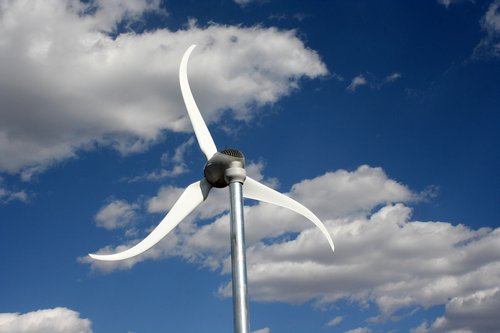
Homeowners, ranchers, and small businesses can install wind turbines, like this Skystream 3.7 residential turbine, to reduce their utility bills. Photo from Southwest Windpower, NREL 15030
If you answered "no" to any of the above questions, you should probably find a system integrator or installer to install your system. Contact the manufacturer for help or call your state energy office and local utility for a list of local system installers.[30]
The North American Board of Certified Energy Practitioners (NABCEP) Small Wind Installer Certification ensured that installers were qualified, but as of July 2012, the NABCEP certification was suspended. Sixteen installers throughout the United States hold the credential. At the NABCEP website, you can find more information or a certified installer.
When you begin contacting installers, consider calling at least three to get a small sample of price quotes. Have your latest electric bill near so you can refer to it, as the installer will likely ask questions regarding how much energy you currently use on a monthly basis.
The following is a list of questions that are important to ask an installer.
- How long has your company been in business?
- How many similar-size projects have you installed?
- Can you provide references and contact information from a few satisfied customers?
- How long will the installation process take?
- Does your company perform all of the work, or do you subcontract some of the labor to other companies? If you subcontract, which portions? Who are the other subcontractors or companies?
- Does the installation estimate include all costs, or are there other costs that are not listed that I am responsible for (shipping, excavation and backfilling, concrete and rebar, tower assembly, turbine assembly, trenching, etc.)?
- Do you provide a warranty for your work? If so, what does it include?
- Do you offer maintenance and repair services?
- Will you train me in the proper operation and shutdown of the turbine?
- What payment schedule do you require in your contract?
- Do you retain the services of a master electrician for the electrical work?
- Have you ever been sued?
A credible installer may be able to provide many additional services such as permitting, obtaining interconnection approval, etc., but it will be at an additional cost and you will have to involve them earlier in the process.[30]
Purchase Equipment
The purchase of a turbine for a small community wind project is a large investment and should be treated like any other major purchase.
Now that permits have been secured and you've chosen an installer (or decided to install the project yourself), it is time to purchase the equipment you will need for the project: the turbine, tower, wire, and interconnection equipment. Based on your previous efforts, a suitable turbine capacity has been determined to fulfill your project needs, and you've researched turbines by reading product literature and learning about power production, warranties, etc. (see Research Turbine Models). With that information in hand, the next step to procuring a turbine for your small community wind project is to contact multiple manufacturers or dealers to see what they have to offer.
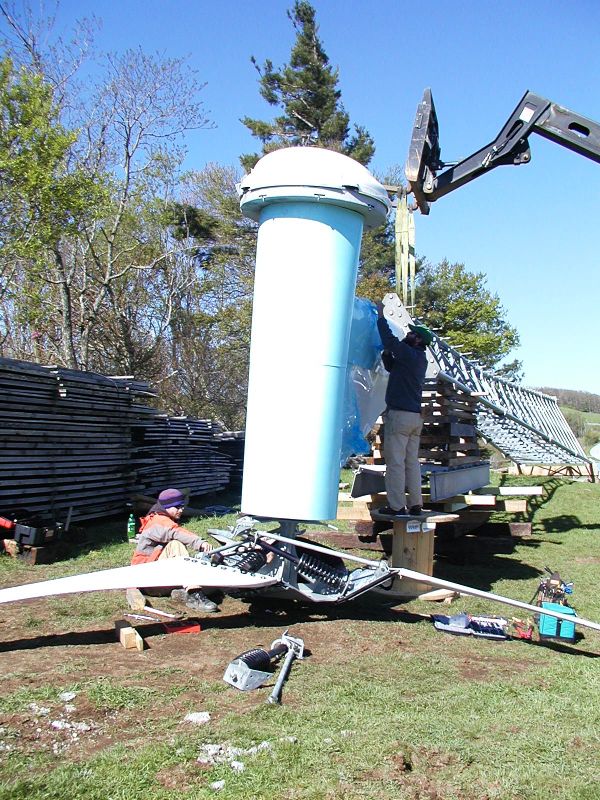
A small community wind project is comprised of multiple components including turbine, tower, wire, and interconnection equipment. Photo from Roger Dixon.
You will have to consider many factors before making your final decision. Manufacturers or dealers should be able to answer the following important questions for you:
- Does the turbine include tower, wiring, components, and other necessary parts and equipment for installation?
- What is the cost?
- How soon will a turbine be available? Some turbine models may not be immediately available due to high demand.
- Are services such as installation or maintenance assistance offered?
- Does the manufacturer offer technical support?
- What is the current availability for replacement parts?
Note that depending on the size of turbine and the type of tower used for the project, you may have to contact a crane rental company to complete the installation.
Plan for Maintenance
Although small wind turbines are sturdy machines, turbine parts experience wear and require annual maintenance. It is important to develop a schedule to ensure that your turbine is operating properly. In a direct-drive machine, alternator bearings and yaw bearings may need to be replaced over time. If you choose a turbine with a gearbox, the lubricant will degrade over time and will need to be changed. Bolts and electrical connections should be checked and tightened if necessary. The machines should be checked for corrosion and the guy wires for proper tension. In addition, you should check for and replace any worn leading edge tape on the blades, if appropriate. After 10 years, the blades or bearings may need to be replaced, but with proper installation and maintenance, the machine should last 20 years or longer.
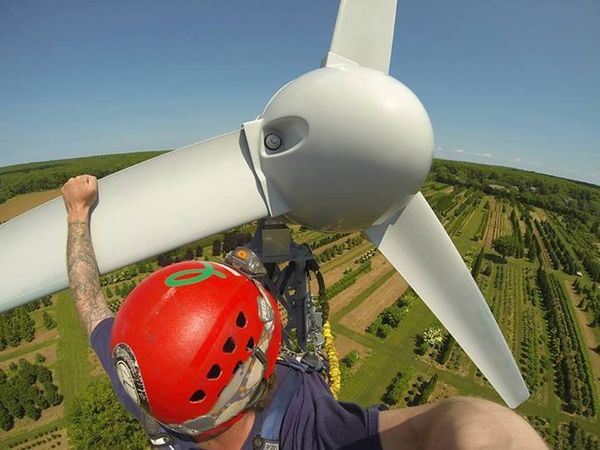
Roy Rakobitsch of Windsine Inc., performs maintenance on a 120-foot tower in East Hampton, New York. Photo from Roy Rakobitsch, Windsine Inc.
Every turbine should include an owner's manual or operations manual to provide the consumer with scheduled and unscheduled maintenance information as well as other unique product information. Scheduled maintenance guidelines should be followed. If you do not have the expertise to maintain the machine, ask whether your installer provides a service and maintenance program.[30]
Typical maintenance issues for a small community wind system include the proximity of someone who is qualified to work on your turbine model, the costs associated with repairs, and allowing minor issues to become major.
References
- Rynne, S.; et al. American Planning Association. Planning for Wind Energy.
- Lantz, E.; Tegen, S. National Renewable Energy Laboratory. Economic Development Impacts of Community Wind Projects: A Review and Empirical Evaluation.
- Jones, C.; Eiser, R. Identifying Predictors of Attitudes Towards Local Onshore Development with Reference to an English Case Study.
- Zoellner, J.; Schweizer-Ries, P.; Wemheuer, C. Public Acceptance of Renewable Energies: Results from Case Studies in Germany.
- McLaren Loring, J. Wind Energy Planning in England, Wales and Denmark: Factors Influencing Project Success.
- Devine-Wright, P. Beyond NIMBYism: Towards an Integrated Framework for Understanding Public Perceptions of Wind Energy.
- U.S. Department of Energy. Distributed Wind Market Report: 2022 Edition
- U.S. Energy Information Administration. Frequently Asked Questions: How much electricity does an American home use?
- U.S. Department of Energy. Installing and Maintaining a Small Wind Electric System
- Interstate Renewable Energy Council. The Intersection of Net Metering & Retail Choice: An Overview of Policy, Practice, & Issues
- The Regulatory Assistance Proejct. Electricity Regulation in the US: A Guide
- National Renewable Energy Laboratory. (2015). Small Wind Site Assessment Guidelines
- U.S. Department of Energy. Small Wind Guidebook: Is There Enough Wind on My Site?
- Small Wind Certification Council. Certified Small Turbines
- U.S. Department of Energy. Small Wind Guidebook: What Do Wind Systems Cost?
- Windustry. Turbine Selection and Purchase
- WINDExchange. Wind Energy Ordinances
- Baltimore County, Maryland. What Is Zoning?
- Oteri, F. An Overview of Existing Wind Energy Ordinances
- Idaho Department of Water Resources, Energy Division. Permitting of Small- and Medium-Size Wind Turbine Projects in Idaho
- Jeer, S. Treatment of Accessory Uses in Land-Based Classification Standards
- NYSERDA. Small Wind: Know the Facts
- U.S. Department of Energy. Frequently Asked Questions on Small Wind Systems
- U.S. Department of Energy. Planning a Small Wind Electric System
- U.S. Department of Energy. Small Wind Site Assessment: Lessons Learned
- Windustry. Wind Resource Assessment
- AWS Scientific for the National Renewable Energy Laboratory. Wind Resource Assessment Handbook
- Windustry. Small Wind Economics
- Forsyth, T.; Tu, P. Economics of Grid-Connected Small Wind Turbines in the Domestic Market
- U.S. Department of Energy. Small Wind Guidebook: Where Can I Find Installation and Maintenance Support?